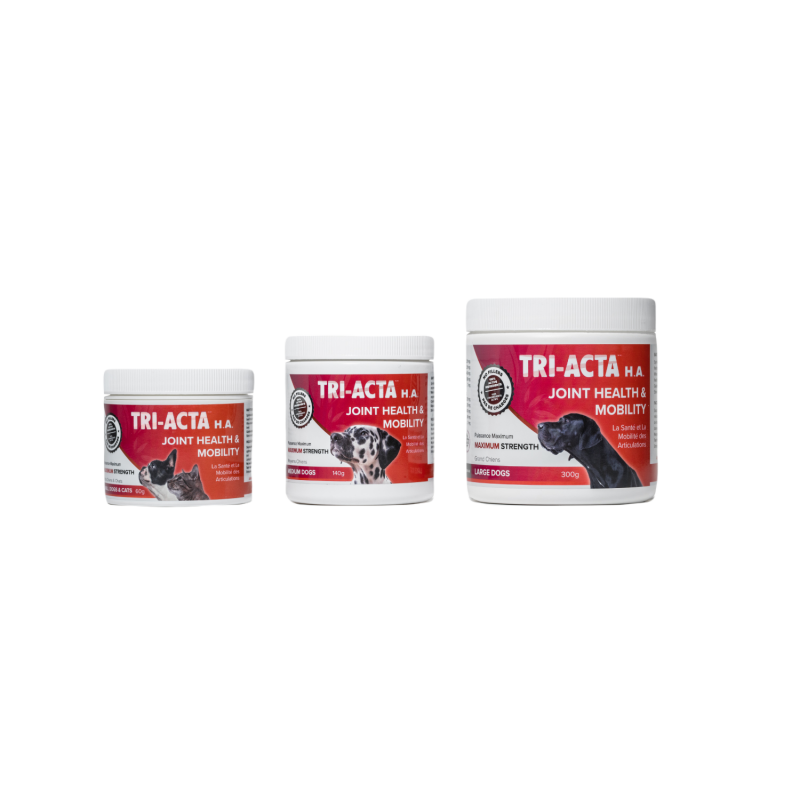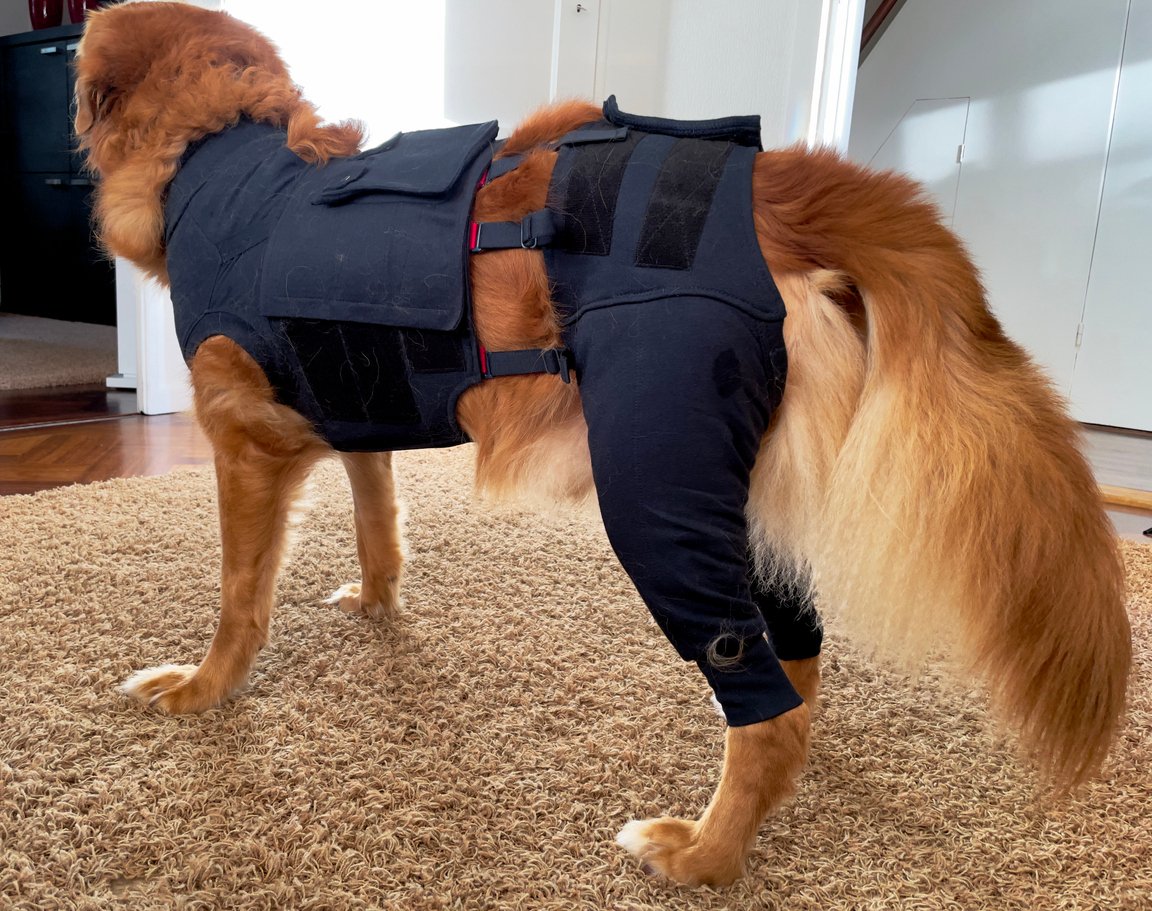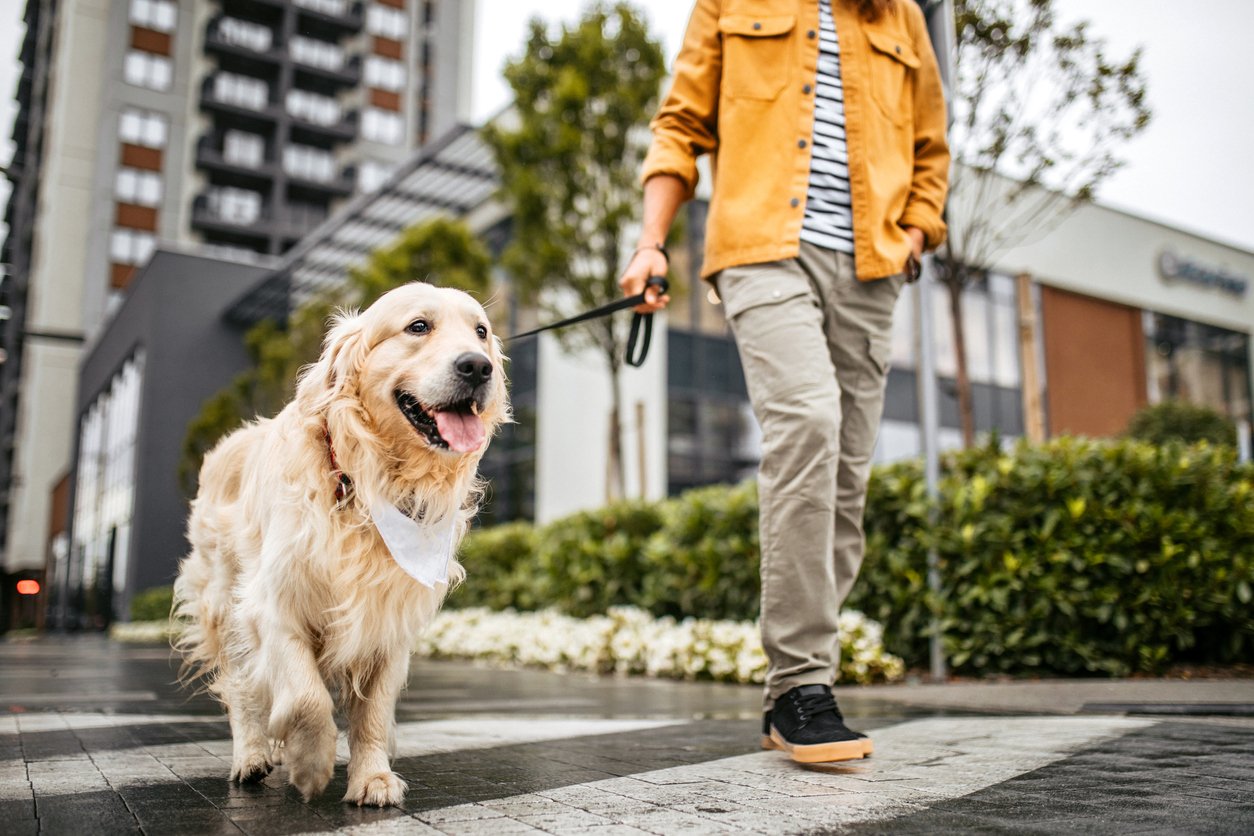Table of Contents
Dogs are the most playful and energetic best friends we could ask for. Whenever we are up for a walk, want to go outside and play, or feel like burning off some energy after a long day at our desk job, we can count on our four-legged friends to join us.
It catches us off guard when our canine pals suddenly lose interest in activities and start to display signs of illness or injury. Swelling on a dog’s hip can be anything from a minor injury or bug bite to a chronic condition like hip dysplasia.
Continue reading to understand the possible causes and appropriate treatment, including when to seek medical advice from a veterinarian for a dog swollen hip area.
Common Causes of Hip Swelling in Dogs
Healthy dogs have healthy joints and bone structure. A pup in good health will be able to run, jump, play, and catch without limping, whining, or showing signs of lameness. If you notice your dog has wobbly hips or is reluctant to rise from a lying or sitting position, it might have a swollen hip area.
Injuries and Trauma
Dogs are naturally energetic and playful. However, they can easily get carried away when chasing an animal, playing with other dogs, or engaging in their favourite games with their owners. Injuries happen with our canine friends. Since hip problems, especially hip dysplasia, are fairly common in dogs, hip injuries are also common.
Dog hip injury causes include:
- Jumping
- Running
- Rough play
- Trauma
A dog hip injury from jumping is one of the most typical causes of a dog swollen hip area. It is especially common in larger breed dogs. If your dog has injured their hip from jumping, they’ve likely stretched their iliopsoas muscle. The iliopsoas muscle is a muscle and tendon combination connecting the pelvis to the femur, responsible for flexing the hip and bringing the leg forward. Injury to the iliopsoas muscle occurs from overuse or hyperextension of the leg.
The most common injuries that can lead to a swollen hip area include:
- Strains
- Sprains
- Dislocated hips
- Fractures
While often used interchangeably, strains and sprains are both soft tissue injuries with distinct differences:
|
Dog Swollen Hip Area Sprain |
Dog Swollen Hip Area Strain |
|
|
In more serious cases, your dog could have a dislocated hip, also known as hip luxation, where the hip joint moves out of its socket. A dog with a dislocated hip will often be unable to bear weight on its leg, compared to a strain or sprain, where it might be limping.
Dog hip fractures are another serious injury that can result in a dog’s swollen hip area. Hip fractures involve breaks in the bones of the pelvis or femur. They usually occur from trauma, such as being hit by a car or having a nasty fall.
Joint and Bone Issues
Dog swollen hip areas can also be caused by chronic conditions such as arthritis and degenerative joint disease, causing dog swollen hip joints.
Signs of Degenerative joint disease (DJD) in dogs include:
- Increased sleeping
- Slower on walks
- Difficulty standing from a lying position
- Resentment to being touched in a certain area
- Sitting with hind legs stretched out
Dog arthritis is a progressive disease that is caused by inflammation and the degeneration of cartilage, bones and joint fluid that comprise joints. Degenerative joint disease (DJD), also known as osteoarthritis, is often a result of hip dysplasia. Dog hip dysplasia is a deformity of the hip joint which occurs during growth. Uniform growth of the hip ball and socket does not occur, resulting in laxity of the hip joint.
Muscle and Soft Tissue Problems
Bursitis is a serious issue that occurs within a dog’s hip area. It refers to inflammation of the fluid-filled sacs (bursae) surrounding the hip joint and connective tissues, muscles, and tendons. It happens when there is damage to muscle and soft tissue, resulting in fluid buildup.
Causes of bursitis in dog hips include:
- Sprains
- Strains
- Infections
- Chronic conditions
Deep tissue bruising and hematomas can occur due to trauma or injury to the hip, causing a noticeably swollen hip area. Hematomas are defined as a localised collection of blood outside the blood vessels. Small hematomas may be reabsorbed by the body and not require intervention. Large hematomas, however, may need to be drained by your veterinarian.
Infections and Other Medical Conditions
A dog swollen hip area can also occur due to an infection or another medical condition.
Infections and medical conditions causing dog swollen hip muscles include:
- Abscesses/Localised infections
- Tumours or growths
- Immune disorders
|
Dog Swollen Hip Area Condition |
Explanation |
|
Abscess/ Localised Infection |
|
|
Tumours or Growths |
|
|
Immune Disorders |
|
A swollen hip area caused by infection or medical issue must be treated seriously and promptly. Even if we know an abscess was caused by our pup playing with the neighbour’s Chihuahua and you know the dog is very healthy, there is still a chance the bite could turn into an infection.
Follow these steps to treat the bite:
- Clean the area: Use a warm compress for 10 minutes twice daily to clean and drain the abscess.
- Apply Pet Safe Antiseptic: Apply a pet-friendly over-the-counter ointment to treat the infection.
- Prevent Licking: Use an e-collar or surgical onesie until the wound is healed.
- Monitor for Infection: Look for redness, increased swelling, and pus.
- Seek Medical Care: Call your vet if the wound does not improve within a few days.
It’s also important to be aware of the signs of an autoiminue disorder in your dog, which exacerbates the development of infections. Canine skin autoimmune disorders present as blisters, pustules, or lesions on the skin, and can appear spontaneously, even if your dog hasn’t been play fighting with the neighbour’s dog or engaged in any other activity that you can recall leading to lesions or irritation on their skin. An autoimmune infection can present as a swollen hip, just as it can present as anything else.
If you suspect the cause of the swollen hipis due to an autoimmune disorder or other medical condition, book an appointment with your vet right away. The earlier you act on chronic health conditions, the better the outcome for your dog's health.
Symptoms of Hip Pain and Swelling in Dogs
It’s not easy figuring out the source of our pet’s discomfort. It can be hard to determine whether your dog is in pain due to bad hips, another body part, or general illness. Since our furry friends can’t talk, we need to figure out what’s hurting them by identifying the symptoms of hip pain and swelling in dogs.
Changes in Movement and Mobility
We know that when we’ve injured a body part, chances are, we won’t be running and dancing to our full capabilities. A dog with a swollen hip area due to an abscess, infection, or injury might suddenly present challenges in mobility. Chronic issues like arthritis or joint issues will likely display gradual changes in your dog’s mobility.
Look for the following five changes in movement and mobility if you suspect that your dog has a swollen hip:
- Dog limping with hip pain
- Changes in gait
- Difficulty standing
- Reluctance to climb stairs
- Refusal to jump, run, or play
If you notice changes in movement or mobility, it’s best to confine your dog to one area on a ground floor with their food bowls and bed nearby.
Signs of Discomfort or Pain
In addition to changes in movement and mobility, your dog might display other signs of discomfort or pain with a swollen hip area. Licking or biting at the affected area indicates something is bothering them. Vocalizing such as whining, wincing, or yelping when moving is another telltale sign of discomfort.
Seek veterinary advice when your dog displays obvious signs of discomfort or pain due to a dog swollen hip area. You can also take a proactive approach to their recovery by offering dog supplements to help with pain and inflammation. TRI-ACTA H.A. contains a potent blend of chondroitin, glucosamine for dogs and MSM, along with hyaluronic acid to help with movement and support for the hip as the joint heals.
TRI-ACTA H.A. for Pets
Our maximum strength formula is optimally designed to accelerate the formation of cartilage, minimize inflammation, expedite the healing process, and improve joint conditions.

Visible Swelling or Hard Lumps
Dogs can be pretty good at hiding their pain, especially younger pups whose main priority is to go outside and play. If you suspect a problem with your dog’s hip, it’s best to examine the hip area for abnormalities.
Abnormalities on a dog's hip may include:
- Visible swelling
- Hard lumps
- Firm lumps
- Spongy spots
- Redness
- Discharge
- Warm areas
Hard lumps and visible swelling on your dog’s hip could indicate strains, sprains, or other injuries. Cysts, tumours, or other growths often present as firm lumps or spongy spots under the skin. Redness and discharge are likely caused by an infection and fluid buildup in the area and will require antibiotics.
Diagnosing a Swollen Hip in Dogs
Diagnosing a dog swollen hip area will likely require a veterinary examination. If you notice a hard, swollen hip that presents for more than a few days, it will require a clinical examination and diagnostic testing.
The steps for diagnosing a swollen hipinclude:
- Veterinary examination
- Diagnostic imaging
- Bloodwork and lab tests
Refer to the chart below for an overview of the steps of diagnosing dog swollen hip areas.
|
Diagnostic Step |
Examples |
|
Veterinary Examination |
|
|
Diagnostic Imaging |
|
|
Bloodwork and Lab Tests |
|
Veterinary Examination
During a veterinary examination of a dog's swollen hip area, your vet will perform a series of manual palpations and movement tests on the swollen hip joint. Palpations are a physical examination technique performed to asses external body parts for irregularities in size, shape, or texture. They will also conduct standard tests such as a temperature check and auscultation (using a stethoscope to listen to the heart, lungs, and arteries).
Diagnostic Imaging
Diagnostic imaging is used to diagnose or confirm irregularities that a regular physical examination cannot identify. They allow vets to visualise internal structures that can’t be seen or felt and assess the severity of an existing diagnosis. For example, if your veterinarian confirms your dog has injured their hip, they might use an X-ray, MRI, or ultrasound to determine what type of injury is causing the dog swollen hip area.
The most common diagnostic imaging tests and what they are used for include:
- X-Rays ((Radiographs): Bones, tumours, fluid accumulation
- MRIS (Magnetic Resonance Imaging): Soft tissue, muscles, tendons
- Ultrasounds: Internal organs, soft tissue, fluid-filled structures
X-rays are effective tools for diagnosing conditions like bone fractures or dog hip dysplasia. MRIs and ultrasounds are best for diagnosing strains, soft tissue injuries, or irregularities like lumps and cysts.
Bloodwork and Other Tests
Once your veterinarian has ruled out an injury or musculoskeletal condition, bloodwork and other lab tests can help assess what is going on internally.
Bloodwork can identify causes of a dog's swollen hip area, such as infections, inflammation, autoimmune disorders, and cancer-related conditions. In cases where there is a lump or persistent swelling, your vet might perform a biopsy or Fine Needle Aspiration (FNA) to assess the cells and tissue for irregularities.
Treatment Options for a Swollen Hip in Dogs
Depending on the cause, treatment options for a swollen hip in dogs will vary. Minor injuries, such as muscle strains or bruising, can often be treated with rest and home care. Bites or small cuts can be treated with basic first aid. Serious injuries or chronic conditions, however, will require medical attention.
Home Care and First Aid
Costly bills and stressful car rides make trips to the vet unfavourable. If your dog displays minor signs of discomfort, you can try home care and first aid as a first treatment option for your dog’s hip.
Home care and first aid for a dog's swollen hip area include:
- Ice packs
- Anti-inflammatory pet supplements
- Heat therapy
- Rest and restricted activity
- Cleaning wounds
- Dog hip brace
Applying an ice pack or cold compress to the swollen area can significantly reduce inflammation. Heat therapy is also an effective way to reduce pain and joint stiffness. It’s important to restrict activity for 24–48 hours to see if your dog’s swollen hip area improves. A dog hip brace supports weak or injured muscles and can help strengthen the hip joint while your dog recovers from a minor injury.
Veterinary Treatments
Vet visits are inevitable when you’re a pet owner. While some dog hip injuries can be treated at home, severe injuries or symptoms lasting longer than a few days require medical attention.
Ask yourself the following questions to determine whether you need to see a vet for a dog swollen hip area:
- Has the swelling lasted longer than 3 days?
- Is there bleeding or discharge that won’t stop?
- Is your dog unable to bear weight on their leg?
- Are there signs of illness like a fever, vomiting, or loss of appetite?
- Was there an incident involving significant trauma?
- Is the area hot or growing in size?
Depending on the cause of the hip injury, your vet might recommend one or more of the following interventions:
- Anti-inflammatory medications
- Physical therapy
- Dietary support
- Joint Supplements
Nonsteroidal anti-inflammatory drugs (NSAIDs) are commonly prescribed to treat pain, inflammation, and fevers in dogs. Think of these as the ibuprofen or aspirin alternative for our four-legged friends. NSAIDs are typically used in conjunction with long-term treatment solutions like physical therapy; your vet will likely prescribe a list of at-home exercises, such as gentle flexing and extending or sit-to-stand exercises.
Your vet might also recommend dietary support, such as reducing caloric intake for weight management, increasing protein for muscle support, or adding omega-3 fatty acids to reduce inflammation. They might also suggest a dog joint supplement for additional hip and joint support.
A joint supplement is especially important because it can not only be used in conjunction with an NSAID safely, but it can also reduce the reliance on NSAIDs over time. This happens because the ingredients in joint supplements like TRI-ACTA H.A. (glucosamine for tissue support, chondroitin for cartilage repair, MSM for anti-inflammatory effects, and hyaluronic acid for ease of movement) work to actually repair the hip joint over time, lessening the need for NSAIDs and therefore reducing the likelihood that your pet will experience the side effects that come with them (mainly liver and kidney issues sometimes leading to failure) as you lessen the dose or even elminate the need for them at all.
TRI-ACTA H.A. for Pets
Our maximum strength formula is optimally designed to accelerate the formation of cartilage, minimize inflammation, expedite the healing process, and improve joint conditions.

Surgical Interventions
If your dog is diagnosed with hip dysplasia, which affects their quality of life, your vet might recommend surgical interventions. The most common hip dysplasia surgeries for dogs include:
- Femoral Head Osteotomy (FHO): Removal of the ball of the hip joint.
- Double or Triple Pelvic Osteotomy (DPO/TPO): Cutting the pelvic bone and rotating the segments.
- Total Hip Replacement (THR): Using plastic and metal implants to replace the hip joint.
Preventing Hip Swelling and Injuries in Dogs
Accidents happen, even to our pets! We can’t prevent every injury or infection, or eliminate the possibility of a long-term health condition, but we can provide our pup with the best tools to support their health.
Joint Supplements
Supplements aren’t just for humans. Dogs benefit from vitamins and supplements that provide additional nutrition that does not come directly from their food.
When choosing a dog joint supplement to support healthy hip joints, choose a product with the following ingredients:
- Glucosamine
- Chondroitin
- MSM (Methylsulfonylmethane)
- Hyaluronic Acid
Refer to the chart below for an overview of the key supplements for healthy joints in dogs.
|
Supplement |
Benefit |
|
Glucosamine |
Repairs cartilage in joints |
|
Chondroitin |
Prevents breakdown of cartilage in joints |
|
MSM (Methylsulfonylmethane) |
Reduces joint inflammation |
|
Hyaluronic Acid |
Lubricates the joints and cushions the bones |
TRI-ACTA is a joint supplement containing a powerful blend of glucosamine, chondroitin, and MSM. It is easy to serve in a small daily dose and contains 100% active ingredients. It is perfect as a preventative measure for young pups who have experienced a mild injury or are prone to hip problems.
For senior dogs, dogs recovering from a severe injury, or those diagnosed with a chronic condition like arthritis, degenerative joint disease, or hip dysplasia, TRI-ACTA H.A. contains added hyaluronic acid to lubricate the joints and provide a maximum-strength formula to speed recovery.
Weight Management to Reduce Joint Strain
While weight might not be a factor in the cause of a dog swollen hip area, extra weight can exacerbate developing conditions that affect the hip. Weight management is one of the easiest and most effective ways to reduce joint strain on both young and aging pups in general
The key factors for weight management to reduce joint strain in dogs include:
- Reduce Calories: Cut down on portions and limit treats.
- Add Fibre: Fibre adds bulk to help feel full while improving digestion.
- Higher Protein: Protein helps maintain lean muscle and promotes fat loss.
- Increase Exercise: Increasing walks, runs, or playtime promotes weight loss while strengthening joints and muscles.
You might also wish to invest in a quality diet dog food to help with weight management. These foods provide portion control and nutrients to support weight loss and optimize dog gut health.
The Importance of Early Detection
As with any health condition, early detection of dog hip problems is essential. Early intervention can improve the recovery time of an infection or injury. Dogs who are treated earlier for chronic hip issues live longer, healthier lives.
Early detection of a potentially swollen hip area in a dog provides the following benefits:
- Slows disease progression
- Reduces pain and inflammation
- Prevents future mobility issues
- Reduces the likelihood of invasive treatments
- Provides better long-term outcomes
Dog Swollen Hip Area: Final Thoughts
A swollen hip in your dog isn’t just a bump; it’s a call to action. Whether it’s rest, home care, a vet visit, or adding joint support like TRI-ACTA H.A., early intervention can make all the difference.
By tackling the cause now, you’re not just easing today’s discomfort; you’re protecting their future zoomies, hikes, and happy dances. With a bit of proactive care, you’ll have your best friend back on all fours, ready for every adventure that comes their way.
Because every day is better when it’s pain-free and full of play.
Purchase TRI-ACTA H.A. online or learn where to buy at a store near you.
TRI-ACTA H.A. for Pets
Our maximum strength formula is optimally designed to accelerate the formation of cartilage, minimize inflammation, expedite the healing process, and improve joint conditions.

Newsletter Signup
Subscribe to our newsletter to receive the latest news and exclusive offers.
.jpg?height=2000&name=Cliick_Integricare-DISPLAY-REVISEDV2%20(1).jpg)
Proactive & Therapeutic Joint Supplements
When given daily, Integricare joint supplements recover bone and joint injuries faster and help prevent mobility injuries from happening in the first place.











